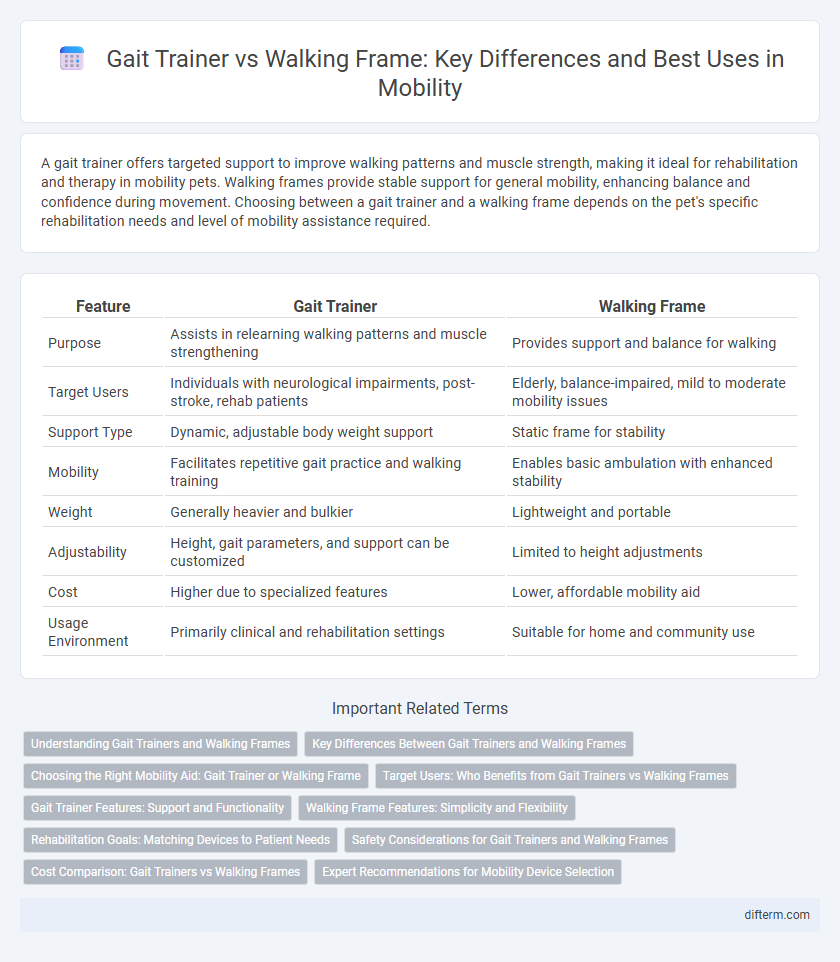A gait trainer offers targeted support to improve walking patterns and muscle strength, making it ideal for rehabilitation and therapy in mobility pets. Walking frames provide stable support for general mobility, enhancing balance and confidence during movement. Choosing between a gait trainer and a walking frame depends on the pet's specific rehabilitation needs and level of mobility assistance required.
Table of Comparison
| Feature | Gait Trainer | Walking Frame |
|---|---|---|
| Purpose | Assists in relearning walking patterns and muscle strengthening | Provides support and balance for walking |
| Target Users | Individuals with neurological impairments, post-stroke, rehab patients | Elderly, balance-impaired, mild to moderate mobility issues |
| Support Type | Dynamic, adjustable body weight support | Static frame for stability |
| Mobility | Facilitates repetitive gait practice and walking training | Enables basic ambulation with enhanced stability |
| Weight | Generally heavier and bulkier | Lightweight and portable |
| Adjustability | Height, gait parameters, and support can be customized | Limited to height adjustments |
| Cost | Higher due to specialized features | Lower, affordable mobility aid |
| Usage Environment | Primarily clinical and rehabilitation settings | Suitable for home and community use |
Understanding Gait Trainers and Walking Frames
Gait trainers provide dynamic support to improve walking patterns and balance, often equipped with adjustable harnesses and wheels for mobility and safety. Walking frames, typically made of lightweight metal, offer static support to enhance stability and confidence during walking but lack the active guidance features of gait trainers. Choosing between these devices depends on an individual's mobility needs, rehabilitation goals, and physical strength.
Key Differences Between Gait Trainers and Walking Frames
Gait trainers provide dynamic support to improve walking patterns and promote muscle strengthening, while walking frames primarily offer static stability for balance and weight-bearing assistance. Gait trainers typically include features such as adjustable harnesses, wheels, and ergonomic designs to facilitate repetitive gait cycles, whereas walking frames are simpler devices designed to support users in maintaining upright posture. The key difference lies in their therapeutic goals: gait trainers aim to enhance mobility through active rehabilitation, while walking frames focus on safety and basic ambulation support.
Choosing the Right Mobility Aid: Gait Trainer or Walking Frame
Selecting the right mobility aid depends on individual stability, rehabilitation goals, and muscle strength; gait trainers provide dynamic support with adjustable features ideal for those needing balance assistance and gait pattern correction. Walking frames offer more rigid support suited for individuals requiring steady, weight-bearing assistance with simpler design and easy maneuverability. Proper assessment by a healthcare professional ensures the mobility aid matches the user's functional needs and enhances mobility independence effectively.
Target Users: Who Benefits from Gait Trainers vs Walking Frames
Gait trainers primarily benefit individuals with significant mobility impairments, such as children with cerebral palsy or adults recovering from stroke, who require support for balance and proper gait pattern development. Walking frames are best suited for elderly users or those with mild to moderate mobility challenges who need stability to prevent falls during walking. Selecting between a gait trainer and a walking frame depends on the user's level of motor control, rehabilitation goals, and need for postural support.
Gait Trainer Features: Support and Functionality
Gait trainers provide enhanced support with adjustable harnesses and dynamic body weight support systems that promote proper posture and balance during walking practice. These devices often include wheels for smooth mobility, brakes for safety, and ergonomic handles to encourage natural gait patterns. Compared to walking frames, gait trainers offer advanced functionality tailored to rehabilitative needs, facilitating improved motor learning and increased independence in mobility.
Walking Frame Features: Simplicity and Flexibility
Walking frames offer unparalleled simplicity and flexibility, making them ideal mobility aids for users requiring basic support and stability. Their lightweight design and adjustable height allow easy customization to varying user needs, facilitating natural gait patterns with minimal learning curve. Unlike gait trainers, walking frames do not constrain movement, providing freedom and adaptability for daily activities and varied terrain types.
Rehabilitation Goals: Matching Devices to Patient Needs
Gait trainers provide dynamic support and promote natural walking patterns, making them ideal for patients aiming to improve balance, coordination, and muscle strength during rehabilitation. Walking frames offer stable support primarily for patients requiring assistance with weight bearing and maintaining upright posture while ambulating. Selecting between these devices depends on specific rehabilitation goals, such as enhancing functional mobility versus providing maximum stability for safe walking.
Safety Considerations for Gait Trainers and Walking Frames
Gait trainers offer enhanced safety features such as harness support and adjustable stability options, reducing the risk of falls during rehabilitation. Walking frames provide basic support with lightweight construction but lack the dynamic assistance found in gait trainers, making them more suitable for users with stable mobility. Proper assessment of individual needs and environment is crucial in selecting between a gait trainer and a walking frame to ensure optimal safety.
Cost Comparison: Gait Trainers vs Walking Frames
Gait trainers generally incur higher costs than walking frames due to their advanced design and supportive features that facilitate rehabilitation and improve gait patterns. Walking frames are more affordable and focus primarily on providing stability and balance for individuals with limited mobility. Investing in a gait trainer may result in better long-term mobility outcomes but requires a larger upfront financial commitment compared to the more budget-friendly walking frame option.
Expert Recommendations for Mobility Device Selection
Experts recommend selecting a gait trainer over a walking frame for individuals requiring enhanced postural support and improved gait pattern training, especially in pediatric and neurological rehabilitation contexts. Clinical guidelines emphasize that gait trainers facilitate dynamic weight-bearing and encourage more natural walking mechanics, whereas walking frames primarily provide static stability for users with limited balance. Personalized assessment of mobility goals, muscle strength, and functional independence remains critical in optimizing device selection for effective rehabilitation outcomes.
Gait trainer vs Walking frame Infographic

 difterm.com
difterm.com